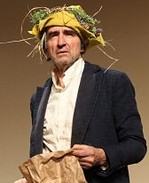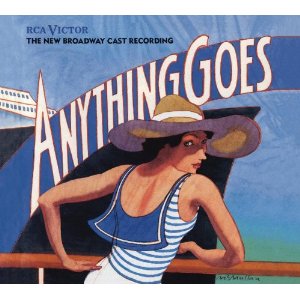SITE GUIDE
SEARCH
REVIEWS
REVIEW ARCHIVES
ADVERTISING AT CURTAINUP
FEATURES
NEWS
Etcetera and
Short Term Listings
LISTINGS
Broadway
Off-Broadway
NYC Restaurants
BOOKS and CDs
OTHER PLACES
Berkshires
London
California
New Jersey
DC
Philadelphia
Elsewhere
QUOTES
TKTS
PLAYWRIGHTS' ALBUMS
LETTERS TO EDITOR
FILM
LINKS
MISCELLANEOUS
Free Updates
Masthead
A CurtainUp Review
King Lear
By Elyse Sommer
| If thou wert my fool, nuncle, I'd have thee beaten/
for being old before thy time. —Fool How's that?—King Lear Thou shouldst not have been old till thou hadst/ been wise.—Fool |

Sam Waterston in King Lear
(Photo: Joan Marcus) |
As Hamlet is every young actor's dream role, so King Lear is the one he sees as the must-do of his later years. And since Waterston played Hamlet 36 years ago at the Public Theater's Central Park Production and later at the Vivian Beaumont when it was under the Public's auspices, it does indeed seem to be the right time for him to keep his date with Lear, and to do so at the Public Theater.
Waterston's image is on the Playbill cover and he's undoubtedly this King Lear's ticket selling draw. The Lear he delivers is certainly interesting, though neither his interpretation or this production overall is likely to be embraced by all theater goers.
As portrayed by Waterston Lear is volatile from the moment he enters the stage, becoming calmer and more sympathetic only after gaining wisdom painfully and too late. Instead of becoming mad gradually, he's out of control from the get-go, stamping his foot, shouting rather than speaking, and revealing himself as a man who makes decisions hastily and willfully. He's jumped into retirement before he's ready to relinquish the right to make unrealistic kingly demands for his daughter's unconditional love and willingness to let him make the lands he cedes them his and his large retinue's home as if he were still in charge. In short, this is a somewhat bi-polar monarch, a hard to love father of daughters (at least 2 out of 3) who like the perennial apples don't fall far from the tree that bore them.
The image of the title character on the Playbill notwithstanding, Waterston's name is listed in alphabetical order on the credits page, which is as it should be for King Lear is more than a star vehicle with its sequence of scenes that delineate the interconnected plots of not one but two fathers who misread their children. The main plot revolves around Lear's rejection of his honest daughter and misplaced trust in the ones who tell him what he want to hear. The subplot focuses on another wrong-headed father, the Duke of Gloucester who misreads his two sons. Whether the characters who swirl around Lear and Gloucester' are duplicitous, if not downright evil or loyal and trustworthy, the actors taking on the roles, may not always be in perfect harmony with one another, but they speak their lines with clarity.
Kelli O'Hara, best known to most theater goers as a peppy musical star, at first had me wondering if she might not have been better cast as Cordelia than Regan. But somehow, despite Lear's curses still causing her to sink to the floor covering her ears, her darker nature's emergence is believable. O'Hara's blonde, prettiness actually makes her cruelty, especially during the famous eye-gouging scene, more scary and memorable than ever. That scene, here staged with remarkably simple inventiveness, is followed by a striking non-verbal moments between Regan and her wounded husband (Frank Wood).
With Enid Graham to play her, Goneril's break with filial devotion is more immediately predictable, though given her unreasonably demanding father you almost sympathize with her wanting to be rid of him and thos hundred nights. Richard Topol, as her husband is fine as an essentially decent man caught up in a web of evil, not to mention a marriage to a woman who has her eyes on someone else.
As for Cordelia, the good sister whose honesty triggers Lear's descent into exile and madness and Edmund, the man both her nasty-girl sister lust for: Kristen Connolly does what she can with the youngest sister who for all her importance to the plot is a relatively minor presence; on the other hand Seth Gilliam as Gloucester's manipulative bastard son has plenty of opportunity to shine—and quite often does so. The actors completing the Gloucester story, with its parallels to the Lear famly saga, Michael McKean's cruelly blinded father wins our sympathy even though he could be a bit grander but Arian Moyayed as the wrongly denounced Edgar makes a strong impression, especially in his Poor Tom though his his dialogue tends to be a bit too frenzied.
John Douglas Thompson, who has in recent years become a much (and justly) praised interpreter of major classical parts (Shakespeare's Othello and Eugene O'Neill's Emperor Jones), is an actor who can and usually does make a big scene bigger. Yet in this production he lends his mellifluous voice to a less showy role. His Kent displays an admirable lack of bombast. His performance is probably the one that stands above all the rest. Too bad that Bill Irwin doesn't bring some of Thompson's restraint to the Fool. In his lemon yellow costume Irwin is as adept in his rubber-legged physicality as ever, but most of the time he seems to have wandered in from one of his clown shows.
The Fool's rain soaked hat is the wildest thing about this Lear's appearance which is far less disheveled than other mad ex-monarchs I've seen. Except for the Fool's canary colored outfit, Gabriel Berry's costumes range from fairly ordinary period nonspecific to a more modern look. (With lots of non-villains walking the streets of New York wearing leather, why do characters like Regan and Goneril always end up in leather as symbolic of the villainous behavior).
Director James MacDonald whose reputaton has been built around modern dramas and cutting edge rather than classic productions, has brought that sensibility with him. The result is a stage kept about as bare bones as you can get: A table covered by a red cloth underneath which is a maquette of Lear's kingdom that's about to be divided between his daughters. No chairs or other props except for a black mesh curtain through which characters will enter and exit.
The opening scene in which Lear has gathered his daughters and their husbands and other courtiers, they kneel, then stand and I expected more elaborate scenery to be rolled on stage before too long. I was wrong. Cordelia's angrily received "Nothing" is also true of the set.
What you see at the beginning is pretty much what you get in the way of scenery throughout. But that table with the marquette and that big mesh curtains do lend themselves to enough dramatics that for me worked as well as some more elaborately staged productons I've seen. Add minor props like the bench that briefly metamorphoses into Gloucester's torture rack and it turns out that the transformative effectiveness of that bare bones staging is not so "Nothing" after all.
|
King Lear by William Shakespeare Directed by James MacDonald Cast: Che Ayende (Duke of Burgundy/Knight/Servant), Craig Bockhorn (Doctor), Kristin Connolly (Cordelia), Michael Crane (Oswald), Herb Foster (Old Man/Curan), Seth Gilliam (Edmund), Enid Graham (Goneril), Bill Irwin (Fool), Michael Izquierdo (King of France), Michael McKean (Gloucester), Arian Moayed (Edgar), Kelli O’Hara (Regan), John Douglas Thompson (Kent) , Richard Topol (Albany), Sam Waterston (Lear). Frank Wood (Cornwall) 1 Scenic design: Miriam Buether Costumes: Gabriel Berry Lights: Christopher Akerlind Sound: Darron L. West Fight Director: Thomas Schall Vocal Consultant: Elizabeth Smith Stage Manager: James Latus Running Time: 3 hours and 25 minutes, including one intermission. Public Theater-Newman, 420 Lafayette Street Tickets: $75-$85; $40 Public Theater members From 10/18/11; opening 11/08/11; closing 11/20 /1 Reviewed by Elyse Sommer at November 5th press matinee |
|
REVIEW FEEDBACK Highlight one of the responses below and click "copy" or"CTRL+C"
Paste the highlighted text into the subject line (CTRL+ V): Feel free to add detailed comments in the body of the email. . .also the names and emails of any friends to whom you'd like us to forward a copy of this review. Visit Curtainup's Blog Annex For a feed to reviews and features as they are posted add http://curtainupnewlinks.blogspot.com to your reader Curtainup at Facebook . . . Curtainup at Twitter Subscribe to our FREE email updates: E-mail: esommer@curtainup.comesommer@curtainup.com put SUBSCRIBE CURTAINUP EMAIL UPDATE in the subject line and your full name and email address in the body of the message. If you can spare a minute, tell us how you came to CurtainUp and from what part of the country. |
 Anything Goes Cast Recording
Anything Goes Cast RecordingOur review of the show
 Book of Mormon -CD
Book of Mormon -CDOur review of the show

Slings & Arrows-the complete set
You don't have to be a Shakespeare aficionado to love all 21 episodes of this hilarious and moving Canadian TV series about a fictional Shakespeare Company

